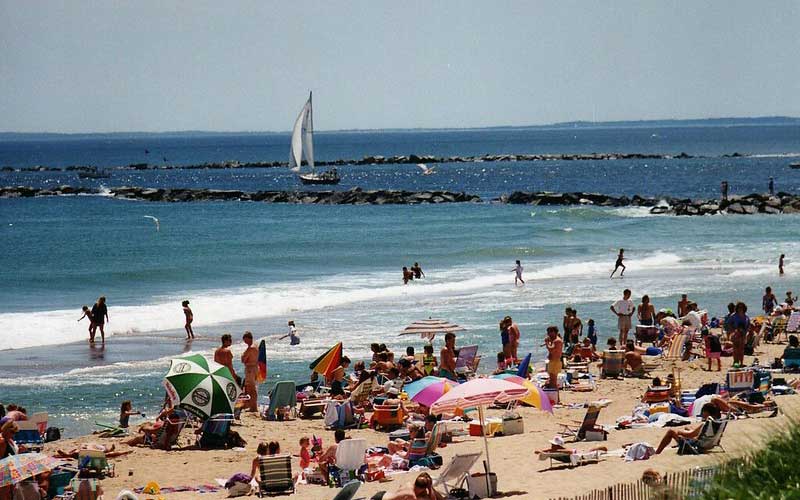
Beach visitors may have appreciated the unusually warm water this summer, but for ocean wildlife, the high temperatures create havoc. Photo: Massachusetts Office of Tourism (CC BY-ND 2.0)
Summer for me has always meant spending as much time as possible at the beach. I’m thankful to live in New England, where we’re just a drive away from some of the country’s most beautiful coastlines. From Maine all the way out to Provincetown at the tip of Cape Cod, our sandy retreats are consistently ranked among the best.
For my family, the chosen spot has always been Salisbury Beach, Massachusetts. Just shy of the New Hampshire border, it’s a four-mile stretch of ocean with the requisite seafood stands, arcades, and a boardwalk lined with old beach bars. Every year growing up, my family would rent a house for a couple of weeks to escape the heat and swim in the chilly ocean.
And it was definitely chilly. The running joke was that you had to be pretty tough to go into the water past your knees until late July, when it might warm up to the mid-60s.
Fast forward to 2021, and things have certainly changed. My mom lives at that same beach now, and I’ve spent a lot of time there this summer. In late August, her neighbor took a thermometer out into the waves over several days and recorded a water temperature that I’d never seen there before: a balmy 75 degrees.
Everyone on the beach that week was talking about how wonderful the warm water was. I couldn’t help but think back to a decade ago when we considered anything above 65 degrees uncommonly warm. I know the climate crisis is causing the Gulf of Maine to warm faster than most other waters on the planet, but it really hits home to experience those impacts myself.
Firsthand impacts
When the ocean hit that abnormal high that week, New England was in the middle of yet another heatwave. We’d sweated through several uncomfortable days over 90 degrees along with the bane of every New Englander’s existence: high humidity. Walking through the hot sand, I saw several mussel shells splayed out along the waterline. That’s hardly an unusual sight, but, looking closely, I could see that the fish were still inside. Their shells had popped open, and they looked as though they had been cooked. They might as well have been served up on a plate at the nearest seafood shack.
This is not normal, I thought, and it caused me to realize just how quickly things have changed here.
Beyond my personal experience, experts tell us that New England’s warming waters are already significantly impacting marine life. Lobster is an iconic food in our region, and lobstering has been a bedrock of the area’s fishing economy for generations. The rapidly heating waters in the Gulf of Maine are affecting both how many lobsters can be found in New England – and where – threatening to upend the industry.
North Atlantic right whales face a similar predicament. The population of the critically endangered whale has plummeted to fewer than 400 in recent years. The species already faces major threats from vessel strikes and entanglements in fishing gear. Now, the Gulf of Maine’s warming waters – and deteriorating food sources – have driven them into unexpected places, putting them directly into the path of more fishing gear and speeding boats.
Another New England icon, Atlantic cod, is also feeling the impacts. Once plentiful off our coast, they have been overfished to record low levels in recent years. The rapidly warming waters are adding insult to injury, impacting their ability to reproduce, among other harms.
What’s next?
What’s become clear is that we can no longer ignore these effects. The U.N Intergovernmental Panel on Climate Change’s recent report makes it known in no uncertain terms that species across the globe are at risk if we don’t slash planet-warming emissions and implement serious conservation measures – immediately.
Almost every New England state now has climate laws on the books that include mandatory cuts in the climate-damaging emissions forcing our ocean to warm. New Hampshire – the last hold-out – needs to catch up and join the fight, and our leaders regionwide need to make sure we reach those goals.
Federal ocean policies also need to match with today’s reality and get serious about conservation efforts. Cod managers are failing to stem the decline of that species, and they need to overhaul their management plan to give the fish a chance at recovery. Recent rules regarding right whale protections also do not go nearly far enough to protect the species, and CLF will soon challenge them in court.
Finally, President Biden must restore full protections to the Northeast Canyons and Seamounts Marine National Monument, which provides a place for species to thrive and saw safeguards decimated under the Trump administration. And, the president should establish more protected areas in our ocean.

To avert climate disaster, we need to act now
Was it a treat to be able to jump in the ocean last month without wanting to scream in pain from cold shock? Of course. But I’ve lived in New England my whole life, and I know that shock just comes with the territory. It’s one of the things we take pride in about living here.
Seeing right whales swimming off our shores and the annual trip to our favorite seafood spot for lobster and cod are also special parts of living in New England, and they’re all under threat from the warming ocean.
We know what needs to be done: Increasing conservation efforts to bring back threatened species and slashing emissions to attack the problem at the source. We’ve made some progress on these fronts in recent years.
Now is not the time to slow down but to double down, because the status quo is quickly becoming unsustainable and uninhabitable.



